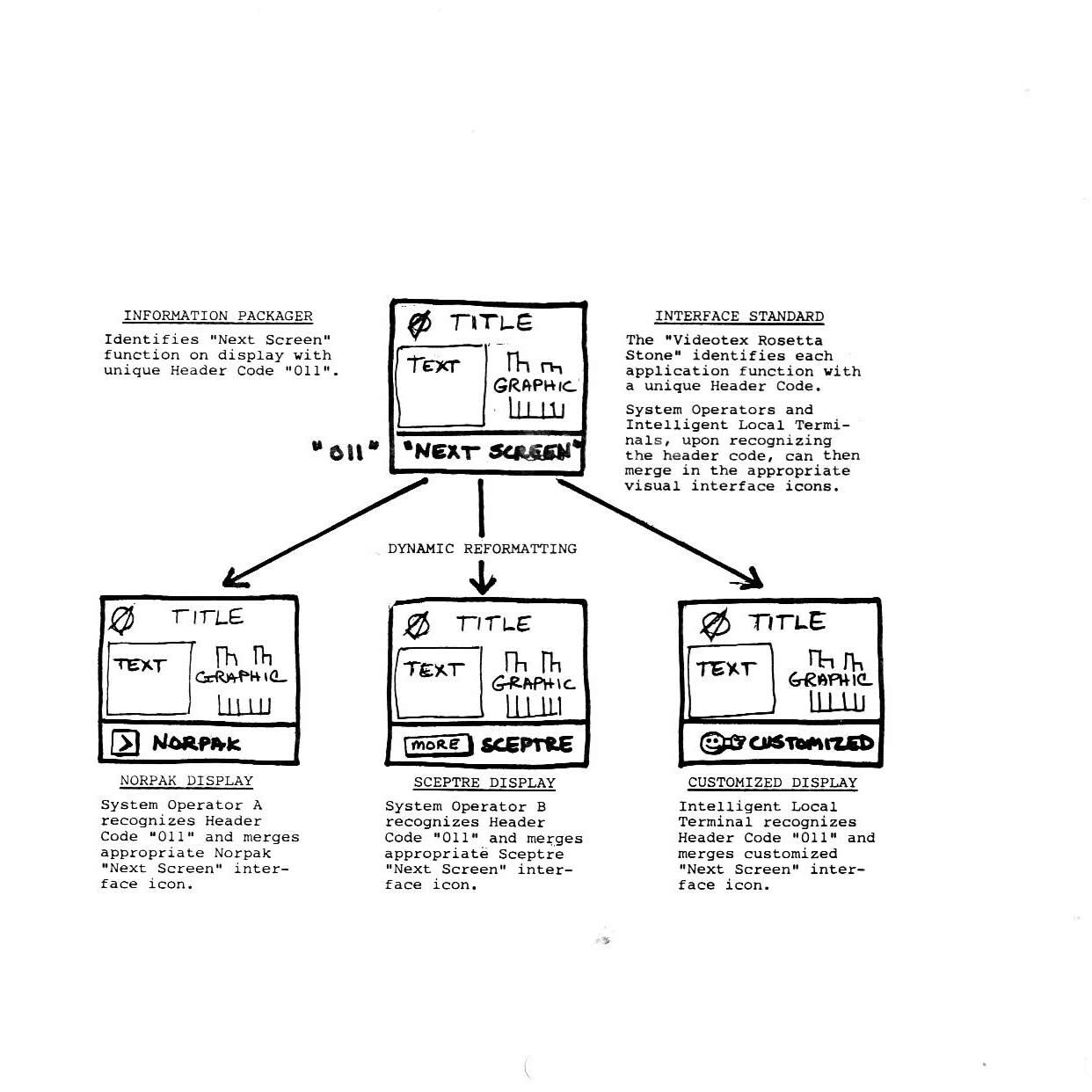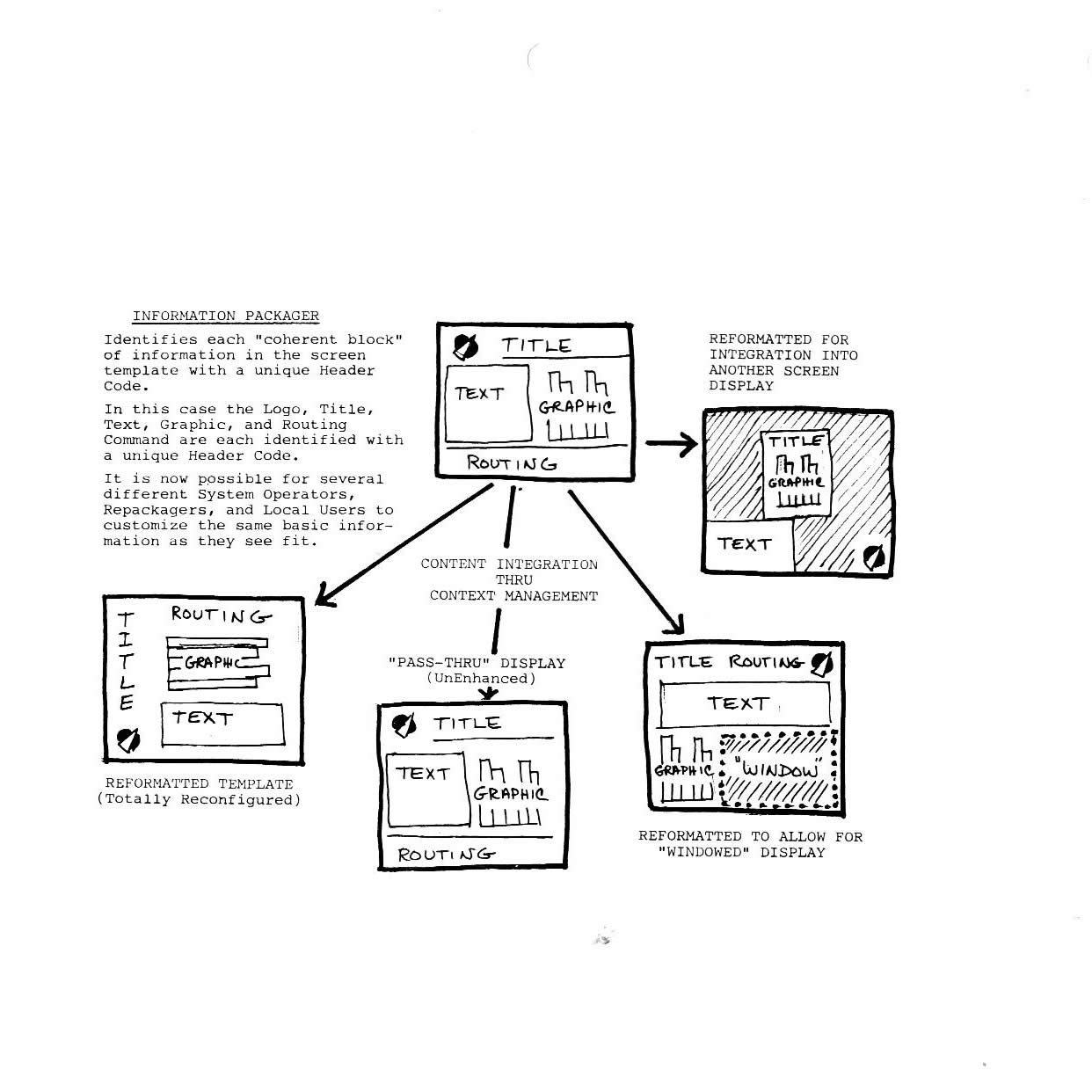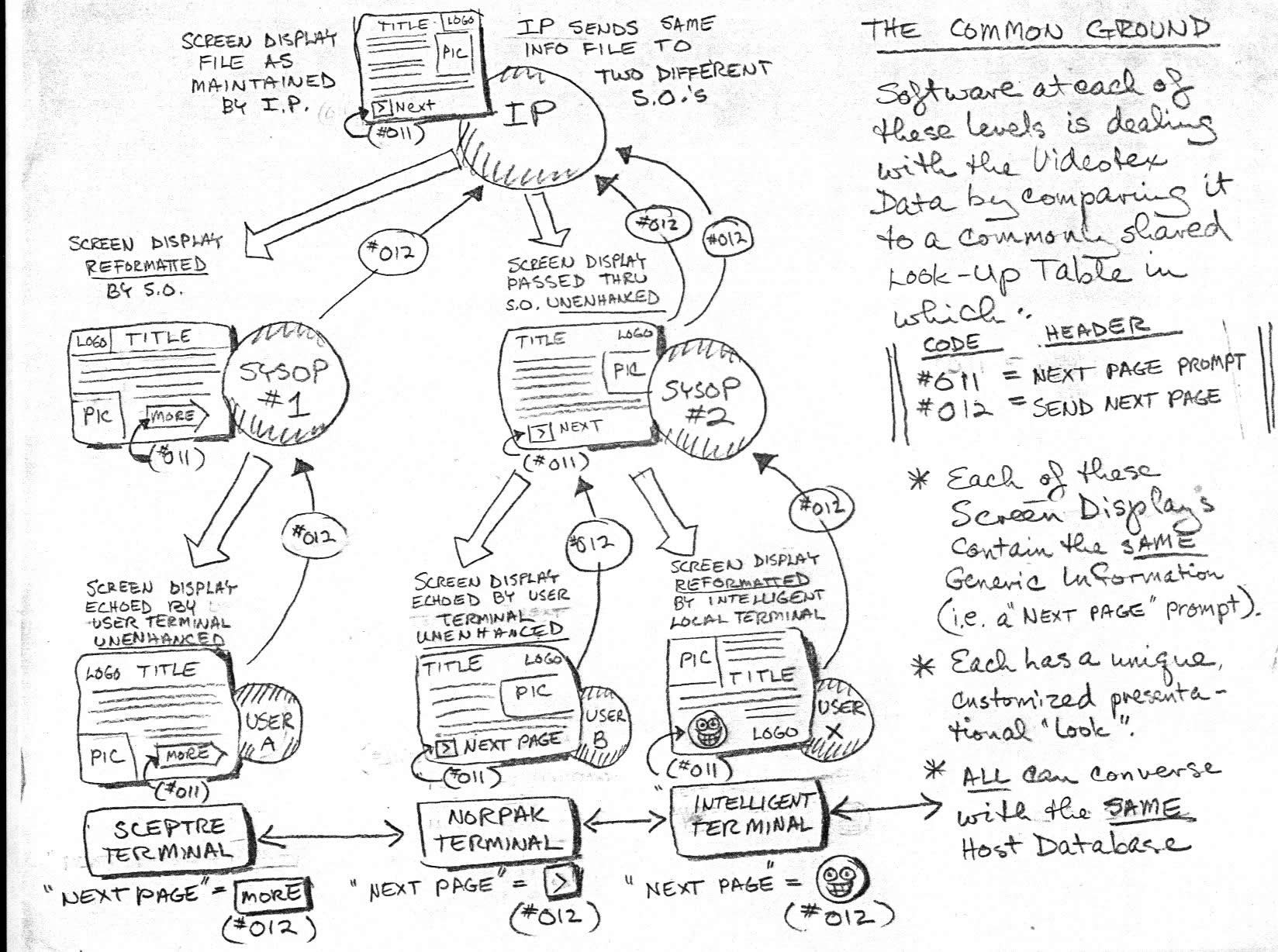Applications Protocol
Individuals mastering these diverse disciplines are abundant, but not so those capable of inventiveness and less so those capable of subordinating that inventiveness to a rigorous and systematic plan.
Jorge Luis Borges
I was a member of the Applications level User Interface Committee (ALUIC) of the Videotex Industry Association. We were charged with coming up with some usage and behavioral standards for an industry that was not yet a real market. Here is my contribution to our report.
Terminology changes over time. In the interest of accessibility, I have replaced the archaic terms that we used in the mid-80's with more timely wording:
"videotex" => "interactive" or "interactive services"
"Intelligent Local Terminal" => "browser"
"NAPLPS" => "vectorgraphics" or "graphics"
"ASCII" = "textual data"
"Headering" => "tagging"
"Buzzwords in good currency" have changed, but a lot of these forward-looking (Well, sort of ... It was 1984) concepts, needs, and solutions remain fundamentally true and valid today.
Some Assumptions
This section is based upon some ASSUMPTIONS about interactive browsers:
- Interactive services will operate upon the intelligent browser (probably as software integrated with a personal computer). The "dumb" hardware terminal will exist primarily as a microcomputer peripheral.
- Unifunctional hardware decoders have a limited lifespan as transitional units in the industry.
- Dedicated hardware decoders operating as peripherals in an intelligent module configuration (PC/Touch-Sensitive-Screen/Videodisc/External Disk Storage/etc.) will probably serve as the developmental bed for converging technologies and enhancements in areas such as; "public" interactive services, educational/training stations, and kiosk applications.
THEREFORE:
- Interactive services screens (occasionally referred to as "pages") will continue to displayed on unifunctional "dumb" decoders over the near term.
- In the near future, and over the long term, interactive services screens will likely be processed through an intelligent software browser.
- Much of the Application Level software and "intelligence" will be stored in this browser rather than at the host. In fact, the browser will sometimes operate as a Host in its own right.
- The software browser provides the user with far more intelligence and processing power than the current SRM of 3000 Bytes of local memory would seem to indicate.
We should develop a set of applications guidelines which will be able to creatively address the "next wave" of interactive services development, which will be based on intelligent local terminals, downloaded software, and more sophisticated database design.
In proposing its recommendations and guidelines, we should differentiate between issues of FUNCTION and issues of STYLE.
The Elemental Standard
We propose that the industry delineate a common Interface Standard which will designate a unique code name (Elemental Header) to each of a range of generic Functions (Applications).
We see the generic Functions as falling in two major areas:
1) The data transmitted from the Host to the User identifies which generic Functions are active at that point (i.e."Next Screen","Purchase", "Menu Choice", etc.).
2) The data transmitted from the User to the Host identifies which Function he wishes to use.
By designating a unique code name for each of a range of applications (whether transmitted from the Host to the User, transmitted to the Host from the User, or processed in an Intelligent Local Terminal), we can assure ourselves of:
- Functional compatibility among diverse systems
- Easy transportability of interactive services files
While still maintaining:
- Flexibility in presentational design
The technique of Elemental Headering can be extended to allow for a variety of screen layout formats as well. In vectorgraphic format it is not necessary to standardize the Location of information on a screen. If the generic functions within a file have been properly headered, then a given screenful of information:
- May be displayed in a variety of stylistic formats and screen layouts
- May be combined (in whole or in part) with other screen displays
- May be further processed by software in the Intelligent Local Terminal
The Elemental Database notion is discussed further in the article "Interactive Architecture and the Role of the Designer" (The Communication Studio) published in the Proceedings from Videotex (interactive services) '84 by Online Conferences.
We believe that, by following this plan of action, the industry can provide a basis for consistency and standardization of Function across the industry while still allowing for a
THE NEED FOR PRODUCTION SOFTWARE
Vectorgraphics are an elegant way to create and store pictures. It is made even more powerful by the fact that it is essentially based upon the existing textual data protocol.
Unfortunately, the companies which are interested in using vectorgraphics for electronic publishing and information exchange have developed neither the techniques nor the software for handling the vectorgraphic code without requiring the operator to be a technical expert. Up until recently almost all production and maintenance utilities have been based on mini or mainframe level hardware which is centralized and generally inaccessible.
THE CONTEXT MANAGEMENT TECHNIQUE
One approach to the issue is to conscienciously separate the Information CONTENT (text, titles, logos, illustrations, graph data, etc.) from the Display CONTEXT (layout, colors, decoder parameters, system prompts, graph and chart styles, etc.). This system of "Context Management" provides a framework for the creation and maintenance of a dynamic, modular, highly integrated information service.
The Context Management technique provides the Editorial Director with a flexible system for Inventory Management on a single integrated workstation. It allows the various members of the Production Team (Artists, Text Editors, Advertisers, Quality Control, Logical Routing, Software Development, etc.) to each work independently while still maintaining product continuity and integration. It also enables the Design Manager to make global changes in screen design by Template swapping. And the Information Provider can adapt his database to the design constraints of different - often incompatable System Operators and decoder devices - with ease.
CONTENT INTEGRATION THROUGH CONTEXT MANAGEMENT
By using Elemental Database design techniques in a Context Management environment, it becomes possible to allow a non-specialist to enter and update the informational "content" of a screen without knowing anything about vectorgraphics.
For example; one can easily create graphic display templates which will automatically merge existing textual data services. Graphics files can be merged into the screen design and graphical attributes such as color, texture and animation can be manipulated with ease. Modest software applications allow the display of statistical data through dynamic vectorgraphics.

Aside from the obvious advantages for the production process, the Elemental Database allows system operators to easily exchange and integrate information from various information providers without laborious screen redesign. Service providers can transport data from one display format to another. Individual users and value-added repackagers can customize the presentation and display of information drawn from a graphic service.


PRODUCTION TOOLS
The environment which is necessary to support a comprehensive production environment includes utilities such as:
TEMPLATE GENERATOR (PHOENIX - in development)
Allows non-specialist to create annotated graphical templates
Tagging UTILITY (TEXTUP)
Allows easy annotation and identification of "coherent blocks" of information
IMAGE AND TEXT UPDATE UTILITY (TEXTUP)
Allows non-specialist to update text and merge graphic files in a template without fear of corrupting graphical screen data
GRAPH AND CHART GENERATOR (TEXTUP)
Transposes data into a variety of graphic chart and graph formats
CONTEXT MANAGEMENT UTILITY (RECODATA DATA FILE MANAGER)
Manages tagging system which allows you to organize contextual and presentational parameters among various services on the database
IMAGE LIBRARY INVENTORY (TCS IMAGE LIBRARY)
Lists and cross references the available graphics "clip art"
GLOBAL ATTRIBUTE EDITOR (GLOBAL SEARCH & REPLACE)
Allows designer to alter graphical attributes in a large or small group of screens without corrupting the content of the screen
ASCII FILE MERGER (AESTHETICON)
Automatically merges pre-existing ASCII files into graphical templates
DATABASE ROUTING EDITOR (ENVIRONMENT)
Allows designer to create logical linkages among screens in a database and manage navigation
DATABASE AUTO ROUTING (in development)
Automatically updates interactive database routing according to global or selective parameters applied to individual screen filenames
DATABASE APPLICATION INTEGRATOR (ENVIRONMENT)
Allows you to link software applications subroutines to specific screens, user key entry or to areas of the database/site
THE LOCAL USER INTERFACE (the browser)
INTERACTION WITH THE HOST
AUTOMATIC LOG-ON Intitiated by a single keystroke, encompasses auto-dialup and parameter setting at local station, and informs host of personal preference parameters
USAGE STATISTICS UPDATE Local user station sends usage statistics to host automatically at end of interactive session
LOCAL TERMINAL UPDATE Usage statistics and personal preference parameters identify whether and what sort of information needs to downloaded to local user before interactive session is initiated
COMMUNICATIONS MANAGER Allows the system (transparently to the user) to take the user on- and off-line, as appropriate to the interaction. This feature functions in the background
DOWNLOADED OR LOCALLY-MAINTAINED SOFTWARE
CUSTOMIZABLE SETUP PARAMETERS Creates a Setup file for the Local User which defines: Default Display Device, Date/Time, User Name/User ID, Communications Port & Parameters, Autodial for Log-on, Local Phone Number, Printer Type, Security Codes, etc.
DEFINITION OF LOCAL USER INTERFACE Navigation utilities and special functions may be assigned to specific keys, text mnemonics, or cursor driven (mouse) screen selection
LOCAL MEMORY MANAGEMENT Allows local decoder to be polled for status of various attributes (including macros, DRCS, domain, etc.); useful for both host interactions and local software applications
DEFINE USER PERSONAL PREFERENCE PARAMETERS User may define preference for particular types of information, presentation styles, or pre-packaging services (i.e. "I want to know what is on the menu at XYZ Cafeteria every day. I want stock quote updates on A, B and C. Give me all "What's Up" announcements regarding computer software classes. Do a text search and alert me of any information in "Global Reports" re "Japanese trade restrictions". Download the Men's Accessories section of the
SOFTWARE APPLICATION SUBROUTINES There are times when it may be preferable to "off-load" certain applications to the local user's workstation so that information may be pre-processed there (possibly off-line), and the resulting data then sent to the host. Order & form entry are particularly likely candidates.
MAINTAIN LOCAL IDENTITY PROFILE
HELP UTILITIES Maintains a mini-database of "help" information "in the background" (Stuctural features of the system, how to navigate, special function keys, database map, keyword list, interactive syntax, tutorial). These can be called up at any time, but are non-destructive to the active screen, so that you can immediately return to where you were in the interactive session and resume interaction
CUSTOMIZED LOCAL STRUCTURE Allows you to maintain a specific range of information locally, gleaned from the central host files but personalized to the individual's needs
CUSTOMIZED LOCAL SOFTWARE Allows you to maintain a range of custom applications for processing or storing data, navigation, and presentation
DATABASE AUTOMATIC UPDATE Automatically updates your local profile at log-on with screens selected according to personal preference parameters
CUSTOMER TOOLS
BILLBOARD SHOWMAKER Allows you to assemble and choreograph a series of screens into a presentational series (SHOW)
PRINTER ACCESS Allows you to take advantage of local printer for capture of screen data
SELECTIVE SCREEN CAPTURE ("INFO-TOTE") Allows you to capture data from a screen and store it locally, perhaps re-processing it through local application utility (such as; Putting information from a "What's Up" announcement into a local Calendar Utility)
SCREEN CREATION & UPDATE Allows user with ordinary keyboard entry skills to enter & update text, custom fonts, bar charts & graphs and graphic clip art into preformatted templates. Useful for creating billboarding business presentations, packaging electronic mail, and filling out interactive order forms. (TEXTUP)
Author: